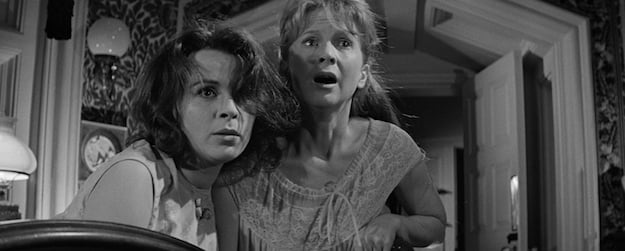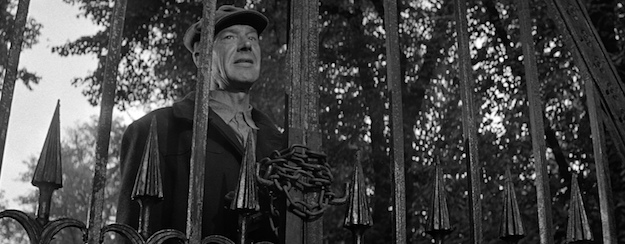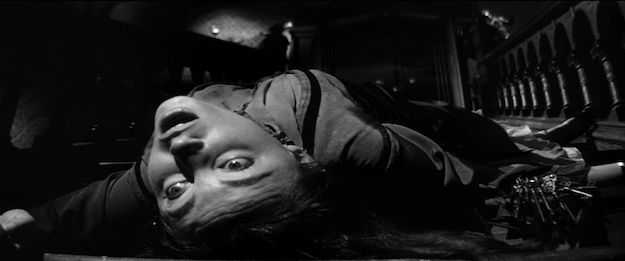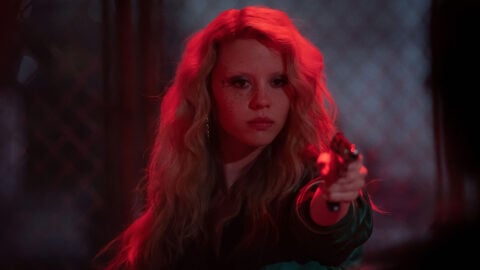Queer & Now & Then: 1963
In this biweekly column, I look back through a century of cinema for traces of queerness, whether in plain sight or under the surface. Read the introductory essay.

In one of the more hair-raising moments of both Shirley Jackson’s 1959 novel The Haunting of Hill House and Robert Wise’s 1963 Hollywood adaptation, more economically—and dully—named The Haunting, protagonist Eleanor, during the middle of one of the many nights she has been willingly staying in the haunted domicile of the book’s title, grabs the hand of her roommate, Theodora, as she lies in her bed in the dark. She has been terrified by the whisperings and taunting, gurgling laughter emanating from the house’s very walls. As Eleanor prays for the moment to pass, she presses on to the other’s hand, “holding so tight she could feel the fine bones of Theodora’s fingers,” wrote Jackson. Wise visually accompanies the distant, disturbing sounds by fixing the camera on a piece of the wall half-illuminated in moonlight, a leafy pattern of molding that seems to abstractly form a gaping face. Suddenly, as Eleanor reaches a fever pitch of anxiety, the lights come on, the monstrous sounds stop, and Eleanor realizes that Theodora has been across the room, in her own bed, the whole time. In both film and book, Eleanor cries: “God, God—whose hand was I holding?”
More than just a creepy illustration of the possibly unfriendly supernatural forces at work at Hill House, this moment speaks indirectly to one of the story’s central oddities, as puzzled over today as the supernatural ambiguity of Jackson’s horror tale: the nature of the relationship between Eleanor and Theodora, played on screen by Julie Harris and Claire Bloom. Though they arrive at Hill House as perfect strangers, Eleanor and Theodora—the only women who have been summoned to stay at this terrible place—enact a delicate dance around one another. All of their interactions are defined by this kind of push-pull, love-hate, fear-comfort, and the simultaneous desire and repugnance of that handholding perfectly stands in for their larger attraction and repulsion. Eleanor, meek and single and likely virginal, has spent most of her adult life taking care of her invalid mother, who has just died; Theodora, bohemian and outspoken, functions as a kind of mirror opposite of Eleanor, instantly dazzling and confident. The women will bond and argue and finally reveal mutual loathing over the course of their weeklong visit to Hill House. Complicating matters considerably is the matter of Theodora’s sexuality. In Jackson’s book, there are many small gestures toward the brasher woman’s lesbianism; the movie teases those out even further, though, in this immediately post-Children’s Hour era, it stops significantly short of clarifying this for its viewers. Theodora’s probable homosexuality exists largely as it relates to Eleanor and her demons.
Robert Wise’s production is a traditionally Gothic bit of horror that somehow remains faithful to Jackson’s book while also managing to flatten its surreal ambivalence and literalize much of its interiority, thanks to an overreliance on voiceover and melodramatic performance style. Jackson’s writing is so evocative and inextricably tied to what makes this story work that both the makers of this film and Mike Flanagan with his new Netflix series that’s very liberally inspired by it (titled, brazenly, The Haunting of Hill House, in a kind of misleading brand-name recognition) chose to begin with narration of passages taken from Jackson’s spectacular first paragraph (“…whatever walked there, walked alone”). Jackson is the real star in all of these cases, and her style and persona permeate all. Arguably, she was more successful as a sculptor of short stories, which more willingly and readily house the ambiguities that fueled her work, cutting things off just when it seems like an explanation or solution could present itself; her masterful, chilling, dark tales “The Summer People” and “Paranoia” especially attest to this, both of which conclude just as something evil is bestirred. As a novel, The Haunting of Hill House extends and attenuates her penchant for emotional obscurity, to a fascinating, maddening degree, localizing it in the common debate about whether what we’re seeing—and what characters are experiencing—is truly psychological or paranormal phenomena. And at a time when same-sex desire was still officially diagnosed as a mental disorder, the appearance of a gay character in a film so preoccupied with emotional disturbance can’t help but raise eyebrows as to intentionality. In the first DSM manual, published in 1952, homosexuality was called a “sociopathic personality disturbance”; five years after The Haunting, it was only slightly improved, when the DSM-II took it out of the realm of sociopathy but still defined it as “sexual deviance.”
Wise is slightly less cagey about Theodora’s sexuality than Jackson, yet the slight opening up ironically makes the characterization seem more reductive. For Jackson, who according to biographers on more than occasion spoke or wrote of her discomfort with critics and scholars identifying latent lesbian themes in her various works, Theodora (nicknamed the butch “Theo”) is not exactly a sexual predator but an agent of disruption nonetheless. Late in the book, when the four main characters (which also include Luke, the wisecracking heir who will inherit Hill House, and Dr. Montague, the supernatural investigator who has invited them all) are discussing what fears them most, Theo’s response is that she’s scared of “knowing what we really want.” Immediately after this happens: “She pressed her cheek against Eleanor’s hand and Eleanor, hating the touch of her, took her hand away quickly.” In Wise’s film, Theo’s line is subtly yet significantly altered. When asked what’s she afraid of, she responds: “Of knowing what I really want,” which is followed by her sly, borderline seductive glance at Eleanor. This also calls back to an earlier moment when, soon after first meeting, Theodora calls Eleanor “my new companion” while knowingly raising a martini to her lips.The Haunting addresses homosexuality, as it had so long traditionally been, in terms of glances and codes—when placed in a horror movie, such suggestions serve to make it seem sinister.

Whether Theodora is actually attracted to Eleanor and making a play for her, or whether she’s just trying to connect, is unclear in both book and film, and also speaks to the sketchiness of the character. As played by Bloom, the ESP-gifted Theo seems a model of self-possession and confidence, wearing stylish, mannish blouses and her hair parted and plastered; yet when her sexuality becomes a topic of suspicion, she shows her vulnerable side. Eleanor, increasingly hysterical, is the opposite, a mild maiden with talons—crueler in the film even than the book, she lashes out when cornered. At one point, Theodora calls her “stupid and innocent,” to which she responds: “I’d rather be innocent than like you.” When Theodora asks her what she means, she responds, with not-so-subtle homophobic invective: “Now who’s being stupid and innocent? You know perfectly well what I mean . . . The world is full of inconsistencies. Unnatural things.” In a cut back to a reaction shot, an offended Theodora begins to retreat, which doesn’t stop Eleanor from landing the final blow: “Nature’s mistakes they’re called. You, for instance.” The shocking nastiness of the comment forces Theodora to snap back around, a defiant woman devastated, arms wrapped around herself. The scene abruptly ends before Theodora is able to say anything, leaving the insult hanging in the air, and all but stanching the teasing erotic flow that had seemed to pass between the two women in earlier scenes. Eleanor’s rejection of Theodora is complete.
For some viewers, this passage might not seem fully legible because of the film’s inability or unwillingness to fully “out” Theodora. Wise revealed in the Warner Brothers DVD’s audio commentary track that the original script by Nelson Gidding featured an early breakup scene that established Theodora’s sexuality more explicitly. Before first setting out for Hill House, she would have been seen writing “I HATE YOU” in lipstick on her bedroom mirror before yelling out of her window at a departing woman. Aside from more directly addressing her same-sex attraction, the scene might have also set her up as tempestuous and unlucky in love. Yet due to its explicitness of theme, Wise says he cut “that lesbian scene.”
Yet no matter how much they tried to hide Theo from us—and from herself—she remains a figure of undulled fascination and strength. Flash forward 55 years to the Netflix series. One of the main characters is named Theo (Kate Siegel) in proper tribute, and she is introduced picking up another woman in a bar and bringing her home for a quick and gratifying sexual bout. Theodora finally gets some, and making subtext text, history gets the last laugh.
Michael Koresky is the Director of Editorial and Creative Strategy at Film Society of Lincoln Center; the co-founder and co-editor of Reverse Shot; a frequent contributor to the Criterion Collection; and the author of the book Terence Davies, published by University of Illinois Press.







